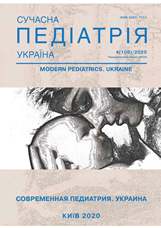Modern clinical and laboratory features of the course of rotavirus infection in young children in Zaporozhye region
Keywords:
rotavirus infection, young children, Vesicary scaleAbstract
Rotavirus infection occupies a special place in the structure of children's morbidity both in Ukraine and around the world, causing severe dehydrating gastroenteritis mainly in children less than five years of age. Almost every child under the age of five carries a rotavirus infection regardless of race and socio-economic status, which makes it an urgent problem in pediatrics and necessitates its in0depth study.
Purpose — To study the clinical and laboratory features of the rotavirus infection course in young children and determine the factors that affect its severity.
Materials and methods. The analysis of the course of rotavirus infection in 57 children aged 1–24 months who were hospitalized in Zaporizhzhya Regional Infectious Clinical Hospital was perfomed. The severity of rotavirus gastroenteritis was determined according to the Vesikari scale and expressed in points (from 1 to 20).
Results. Children aged 12–24 months accounted for most of the study group — 47.3%, significantly exceeding the number of children under the age of 6 months — 22.8% (p=0.01). In most patients (70.2%) rotavirus infection proceeded in a severe form with a total amount of 15.00 [13.00; 16.00] points on the Vesikari scale. 52.6% of children had complications of the disease, among which the secondary acetonemic syndrome dominated. The disease was significantly more severe in children aged 12–24 months. Their total score was 13.5 [12.00; 15.00], against 10.00 [8.00; 15.00] in children under the age of 6 months (p=0.04) and 12 [10.00; 15.00] in patients aged 6–12 months. Clinical parameters that were assessed as severe by the Vesikari scale and caused a severe course of the disease were the duration of diarrhea (>6 days — 82.1% of children), the maximum number of stools per day (> 6 times — 69.6% of children) and hyperthermia (pyretic body temperature — 45.8% of children). Such comorbid pathology as food allergy and atopic dermatitis was significantly more often detected in children with severe rotavirus infection compared with patients with a mild illness — 40% versus 11.8% of children, respectively (p<0.05).
Conclusions. Rotavirus infection is severe in young children and in most cases has complications. Predictors of its severe course are the age of children 12–24 months and the presence of such comorbid pathology as food allergies and atopic dermatitis.
The research was carried out in accordance with the principles of the Helsinki Declaration. The study protocol was approved by the Local Ethics Committee of these Institutes. The informed consent of the patient was obtained for conducting the studies.
References
Baranov AA, Namazova-Baranova LS, Tatochenko VK, Vishneva EA, Fedoseenko MV, Selimzianova LR, Lobzin YV, Kharit SM, Bekhtereva MK, Briko NI, Mindlina AY, Kudryavtsev VV, Gorelov AV, Podkolzin AT, Kostinov MP. (2017). Rotavirus Infection in Children is an Unsolved Problem. Review of Guidelines for Vaccinal Prevention. Pediatric pharmacology. 14 (4): 248–257. https://doi.org/10.15690/pf.v14i4.1756.
Chernyshova LI, Teslenko MYu, Radionova NM, Kasyan OI. (2017). Clinical course of rotavirus gastroenteritis in children younger than 5 years in recent times. Sovremennaya pediatriya. 4 (84): 96–100. https://doi.org/10.15574/SP.2017.84.96
Crawford SE, Ramani S, Tate JE, Parashar UD, Svensson L, Hagbom M, Franco MA, Greenberg HB, O'Ryan M, Kang G, Desselberger U, Estes MK. (2017). Rotavirus infection. Nature reviews. Disease primers. 3: 17083. https://doi.org/10.1038/nrdp.2017.83; PMid:29119972 PMCid:PMC5858916.
Gervasi G, Capanna A, Mita V, Zaratti L, Franco E. (2016). Nosocomial rotavirus infection: An up to date evaluation of European studies. Journal Human Vaccines & Immunotherapeutics. 12 (9): 2413–2418. https://doi.org/10.1080/21645515.2016.1183858; PMid:27185183 PMCid:PMC5027725.
Honglang Chen, Lijun Song, Guixian Li, Wenfeng Chen, Shumin Zhao, Ruoxia Zhou, Xiaoying Shi, Zhenying Peng, Wenchang Zhao. (2017). Human rotavirus strain Wa downregulates NHE1 and NHE6 expressions in rotavirus-infected Caco-2 cells. Virus genes. 53 (3): 367–376. https://doi.org/10.1007/s11262-017-1444-0; PMid:28289928.
Kramarev SO, Zakordonets LV. (2019). Rotavirusnaya infektsiya u detey: profilaktika i lechenie. Zdorove rebenka. 14 (3): 86–91.
Margaret Mokomane, Ishmael Kasvosve, Emilia de Melo, Jeffrey M Pernica, David M Goldfarb. (2018). The global problem of childhood diarrhoeal diseases: emerging strategies in prevention and management. Ther Adv Infect Dis. 5 (1): 29–43. https://doi.org/10.1177/2049936117744429; PMid:29344358 PMCid:PMC5761924.
Nezgoda II, Naumenko ON. (2016). The course of rotavirus infection in children at the present stage. Preventive medicine. 1–2 (26): 73–77.
Ogilvie I, Khoury H, Goetghebeur MM, El Khoury AC, Giaquinto C. (2012). Burden of community-acquired and nosocomial rotavirus gastroenteritis in the pediatric population of Western Europe: a scoping review. BMC Infecious Diseases. 12: 62. https://doi.org/10.1186/1471-2334-12-62; PMid:22429601 PMCid:PMC3342230.
Pikul KV, Bobyreva LE, Kushnereva TV, Il'chenko VI, Priluckiy KYu. (2017). Rotavirus infection in children as of today (literature review). Wiadomosci Lekarskie. 70 (3): 622–627.
Shim DH, Kim DY, Cho KY. (2016). Diagnostic value of the Vesikari Scoring System for predicting the viral or bacterial pathogens in pediatric gastroenteritis. Korean J Pediatr. 59 (3): 126–131. https://doi.org/10.3345/kjp.2016.59.3.126; PMid:27186219 PMCid:PMC4865623.
Tate JE, Burton AH, Bosch-iPinto C, Parashar UD. (2016). Global, regional, and national estimates of rotavirus mortality in children <5 years of age, 2000–2013. Clinical Infectious Diseases. 62: 96–105. https://doi.org/10.1093/cid/civ1013; PMid:27059362.
United Nations International Children's Emergency Fund. (2018). Diarrhea. URL: http://www.data.unicef.org/topic/child-health/diarrhoeal-disease/ Ref list.
WOZ. (2018). Epidemiologicheskaya spravka WOZ. 1: 18. URL: http://www.euro.who.int/__data/assets/pdf_file/0004/371434/epibrief-1-2018-rus.pdf?ua=1.
Downloads
Published
Issue
Section
License
The policy of the Journal “MODERN PEDIATRICS. UKRAINE” is compatible with the vast majority of funders' of open access and self-archiving policies. The journal provides immediate open access route being convinced that everyone – not only scientists - can benefit from research results, and publishes articles exclusively under open access distribution, with a Creative Commons Attribution-Noncommercial 4.0 international license (СС BY-NC).
Authors transfer the copyright to the Journal “MODERN PEDIATRICS. UKRAINE” when the manuscript is accepted for publication. Authors declare that this manuscript has not been published nor is under simultaneous consideration for publication elsewhere. After publication, the articles become freely available on-line to the public.
Readers have the right to use, distribute, and reproduce articles in any medium, provided the articles and the journal are properly cited.
The use of published materials for commercial purposes is strongly prohibited.

